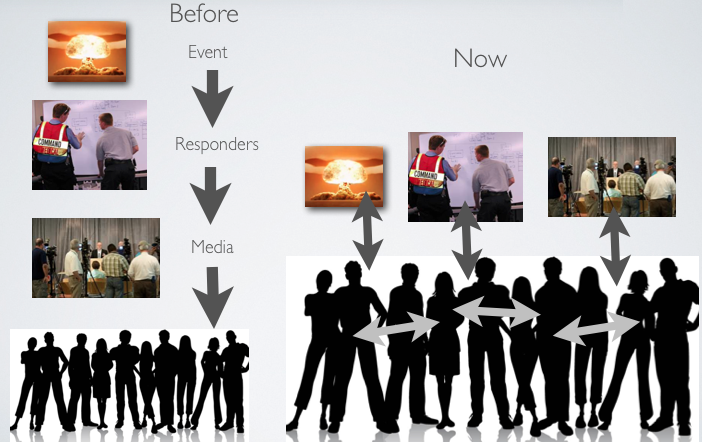In the same time-frame but a different context, Alberto Cottica's resignation post talks of the difficult interface between bureaucracies and networks.
"Kublai’s story seems to be representative of a tough problem in public policy: administrations find it hard to manage the interface with the online communities they collaborate with – even if they originate them ." He talks of the mismatch between Weber bureaucracies and web-based networks.
This mismatch is usefully seen within the Cynefin framework as the need to move between the complicated domain and the complex domain.
Lee Clarke discusses the interface in 'Worst Cases'. He doesn't use Cynefin, but the mapping is pretty clear:
"Concentrated, high-technology systems are more prone to catastrophic failures than others. Charles Perrow's book 'Normal Accidents' shows that many of our most dangerous technologies actually require centralized organizations to function properly. Nuclear power plants, for example, simply can't be run by anything other than a highly secretive bureaucracy that's utterly dependent on expert knowledge. That's fine when everything is going well, but when things start to go badly people in highly centralized organizations have a hard time recovering from cascading failures, they have a hard time learning from their mistakes, and society has a hard time looking inside of them to regulate them properly.
...
An estimated five hundred thousand people left Manhattan on 9/11 in one of the largest water-borne evacuations in history. How did that happen? Barges, fishing boats, pleasure boats, ferries, all manner of watercraft carried people to safety. It wasn't driven by an official plan. No one was in charge. Ordinary people, though terrified, boarded the vessels in an orderly way.As a rescue system, it was flexible, decentralized, and massively effective.
...
What does this mean we ought to do? It means we should eschew the centralization of disaster resources in large bureaucracies. Such centralization actually increases vulnerabilities, because centralization is more likely to create systems that don't fail gracefully. It means officials should see the public as an asset in disaster planning and response, rather than as a hindrance. People can generally handle bad news if they believe they are being dealt with honestly and with fealty. It means that local citizens groups should be involved in setting policies. Above all, it means that important choices should be made in a more open and transparent manner. This will necessarily entail inefficiencies and irrationalities, but that is of little consequence in the larger scheme of things.
...
I'm recommending that we foster preemptive resilience. "
Amanda Ripley has stressed the value of some training for the ordinary citizen rather than putting all training effort into specialist emergency services.
Another viewpoint, compatible with Cynefin, is the Competing Values Framework. Value Based Management.net gives a good summary .
Competing values and reforming public management (.pdf) by the Work Foundation introduces the Competing Values Framework (with some unnecessary modification) in a public management context and has a helpful discussion of UK public sector reforms using the framework.
The government-network interface is between the inward-looking control oriented Internal Process values and the outward-looking adhocracy of Open Systems. These fundamentally different value sets are at the root of issues around 'Big Society' and much else.
Several of the Fukushima resources have been built using social networking technology aimed at supporting people during a crisis. For example, a general site for people developing crisis-related internet resources is http://www.crisismappers.net/ and Google have developed http://www.google.com/crisisresponse/ . Example sites related to crowdsourcing Fukushima-related information include:
- Radiation readings on maps: http://community.pachube.com/node/611 and http://japan.failedrobot.com/ and http://www.rdtn.org/ http://www.alttokyo.com/tokyo-radiation-2/ and http://www.ustream.tv/channel/geiger-counter-tokyo and http://radiationnetwork.com/ .
- Wikis http://wiki.crisiscommons.org/wiki/Honshu_Quake and http://jpquake.wikispaces.com/ .
- A portal http://tasukeaijapan.jp/.
Optimistic update: There have always been government hierarchies with operating procedures that can cope with complexity. For example.
If you think that reporting during incidents should be left to 'professionals' and crowdsourcing might be irresponsible, try this.
Second optimistic update: the story of safecast is well worth reading.
Patrice Cloutier has a good piece called Capability Based Planning: the Canadian perspective and my reaction.
Great graphic from Gerald Baron. (Click on it to see it properly).

And last of all as usual, the end-user. Chief Bill Boyd has an excellent blog.



No comments:
Post a Comment